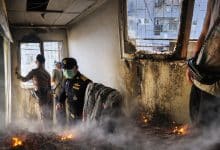Cathay soars again: A350 fleet back in action after fiery setback

Cathay Pacific Airways triumphantly re-launched its Airbus A350 aircraft, after a dramatic engine fire grounded the fleet and caused the cancellation of 90 flights over the past week. The fiery incident uncovered a rare issue with fuel hoses, triggering an urgent, large-scale inspection and repair operation across the airline’s A350 lineup.
With 48 of these widebody jets under Cathay’s wing, the chaos reverberated through the airline. It wasn’t just Cathay affected, the European aviation regulator swooped in, mandating immediate checks for all carriers using similar aircraft, with a strict one-month deadline.
Come Saturday, Cathay Pacific proudly announced that the comprehensive maintenance on its A350 fleet was complete. The skies are now clear for take-off once again, as the airline moves past its fiery ordeal, said a Cathay Pacific spokesperson.
“Cathay Pacific advises that maintenance activity on its operational Airbus A350 fleet has been completed. All A350 aircraft that require replacement have gone through successful repairs and cleared for operation.”
The airline grounded the planes after discovering a problem with an engine part manufactured by Rolls-Royce. The issue was identified after Zurich-bound flight CX383 returned to Hong Kong shortly after take-off on September 2 due to a serious engine fire. This was later confirmed by the European Union Aviation Safety Agency (EASA).
A source told the South China Morning Post that deformed fuel pipes, used to transfer fuel, were the cause behind the engine part failure. The carrier faced no mandate from the manufacturer or any regulator to inspect or replace the pipes at that time.
Engine fuel lines
By Wednesday, Cathay Pacific identified 15 aircraft out of its 48-strong A350 fleet that needed replacement of engine fuel lines. Six of these aircraft were repaired and cleared to operate, with the remaining nine expected to be ready by Saturday.
The engine problem also led other airlines, including Singapore Airlines and Japan Airlines, to conduct similar inspections. The European aviation regulator took precautionary measures to prevent similar incidents, said the regulator.
“We will require a one-time fleet inspection, which may be applicable only to a portion of the A350 fleet, in order to identify and remove from service any potentially compromised high-pressure fuel hoses.”
An emergency airworthiness directive was later issued by the regulator, calling for phased inspections of flexible fuel hose connections inside Rolls-Royce Trent XWB-97 engines, which power A350-1000 aircraft. These inspections are to be carried out within three to 30 days, depending on the engine’s history.
Globally, there are 86 A350-1000 aircraft in service. According to flight data provider Cirium, Qatar Airways operates a fleet of 24 A350-1000 passenger planes, followed by Cathay with 18 and British Airways with 17, said Florian Guillermet, executive director of EASA.
“This action is a precautionary measure, based on the information received from the initial investigation of the recent Cathay Pacific serious incident and on the airline’s findings in its own subsequent inspections. We will continue to follow closely all information that will be made available through the ongoing safety investigation.”
Thorough inspection
Hong Kong’s Civil Aviation Department confirmed on Friday that the agency’s directive applied to all airlines using A350-1000 aircraft. This confirmation came after an online meeting with the regulator on Wednesday to discuss the investigation’s direction, Bangkok Post reported.
Cathay Pacific had already conducted a thorough inspection of its fleet and complied with the directive, said a Cathay Pacific spokesperson.
“The [department] attaches great importance to aviation safety, seeking to ensure all the A350 planes passing through Hong Kong comply with the directive.
“We will continue to follow up the investigation and keep close contact with the European Union Aviation Safety Agency, and the engine manufacturer for further action to ensure aviation safety.”
Latest Thailand News
Follow The Thaiger on Google News:


























